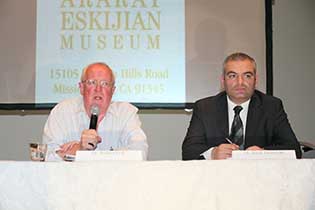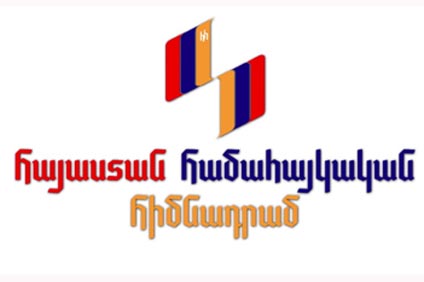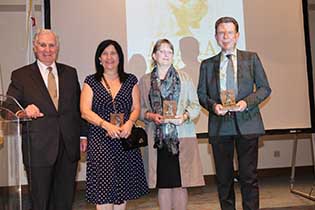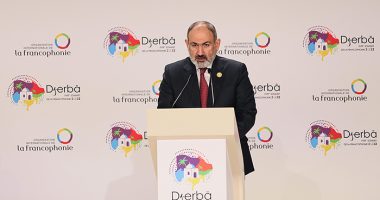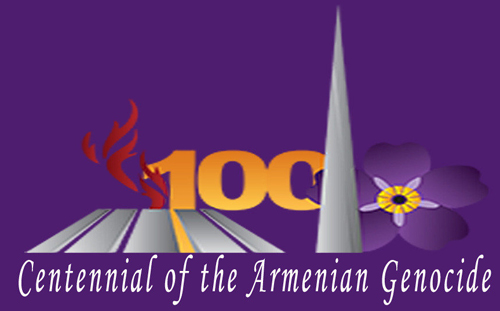By Hasmik Piliposyan
MISSION HILLS, CA — On March 22nd, 2014 at the Ararat Home of Los Angeles in Mission Hills, where our surviving elders still reside, the Ararat-Eskijian Museum hosted an all-day International Conference, “Honoring Those Who Helped Rescue a Generation of Armenian Survivors 1915 -1930”. The event was well attended by the community. Dr. Carla Garapedian, director of ‘Screamers,’ was mistress of ceremonies for the day. The conference opened with pre-recorded speeches addressed to the Armenian community by United States Representatives Adam Schiff and Mike Gato Assembly member 43rd district.
The purpose of the conference was to pay tribute to all those countries, individuals, and organizations that had sacrificed so much to aid a perishing nation. Diplomatic representatives were invited from twenty countries, including New Zealand, China, Japan, Philippine, South Korea, Switzerland, Sweden, France, Britain, Lebanon, Syria, Palestine, Czech Republic, Germany, Royal Danish consulate, Canada, and South Africa, with three diplomatic deputies attending, importantly those of Greece, Norway and Australia.
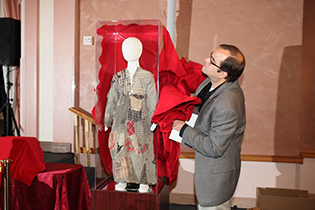

Leading scholars from around the world discussed the manner in which the international community, including the American Red Cross, American Near East Relief, and the League of Nations, participated in making the first major humanitarian effort of the twentieth century.
Missak Kelleshian described the Near East Relief (NER) humanitarian organization, in which the “world united in selfless service to humanity.” Through trauma relief, education, empowerment, self-reliance, parenthood by proxy, education, and nutrition, the NER assisted an entire generation of Armenian orphans to maintain their heritage and reintegrate into society. “Quite literally,” Kelleshian emphasized “Near East Relief kept and entire nation alive”.
Shant Mardirossian has been a member of the Board of Directors of the Near East Foundation since 2002 and its Chair since 2007, in turn, discussed the continuation of the Near East Relief’s work in many areas in the Middle East and Armenia today. “Ninety-nine years later the NER is still prominent throughout the world.” The Near East Relief has kept alive its principle of honoring the past and continuing our national legacy with many humanitarian projects. Prof. Vahram Shemmassian (director of the Armenian Studies Program at California State University, Northridge) described the work of the American Red Cross in rescuing and rehabilitating survivors in the Arab Near East, in nations such as Syria and Lebanon, and author Dr. Rubina Peroomian spoke of the various missionaries that served in the Armenian provinces in the Ottoman Empire and became witnesses to the mass atrocities against the Christian Armenian population. Missionaries from Sweden, Germany, United States, and other nations sent letters, telegrams and other communications to their governments warning of the humanitarian crisis in the Ottoman Empire, and were also instrumental in saving thousands of Armenian children from a tragic fate.
Guests of the conference were moved with emotion at the “Orphan dress from Hadjin,” a patchwork of a deported child’s sole garment, and an unfinished rug created by the orphans, which Mennonite Missionary Sister Dorinda Bowman brought with her on her return to the United States from Turkey in 1914. The items are on loan from Bethel College in Indiana to the Ararat-Eskijian Museum for two years. Also on loan for the day of the conference from a San Francisco patron was a jewelry box made by the orphans of Sivas.
Dr. Hayk Demoyan, the director of the Armenian Genocide Museum-Institute in Yerevan, spoke about Aurora Mardiganian—”Why was America’s Heroine was Condemned to Oblivion?” Demoyan presented newly revealed and unknown materials related to Aurora Mardiganian and movie Ravished Armenia”. Aurora was a girl from Chmshkatsag in the Ottoman province of Kharpert (Harput/Mamuret ul-Aziz), the daughter of a wealthy family who was kidnapped during a death march and sold into the slave markets of Turkey. She eventually escaped, and with the help of the Near East Relief made it safely to New York. Aurora authored Ravished Armenia, the story of her survival, which led to the creation of the silent film, Auction of Souls. This was the first movie about the Armenian Genocide. Aurora played the leading role herself.
Bared Maronian, the award winning director of the documentary of “Orphans of the Genocide” screened a brief portion of his documentary. He showed an emotional visual journey through never-before-seen archival footage and recently-discovered memoirs of orphans who lived through the last century’s first, fully documented, and least recognized genocide.
Dr. Vatche Mankerian gave a powerful performance on the piano of the works of Father Gomidas. Before his performance he gave tribute to his family members, the Mankerians from Hadjin. Over three hundred family members perished and only handful survivors.
Finally, Dr. Robert Fisk, a British writer and Middle East correspondent for the UK newspaper, The Independent, flew in from Damascus to participate in the conference. A century ago, Ottoman Armenians were marched to their deaths in the Syrian Desert. Now, with the recurring accounts of massacres in the Syrian conflict, including the killings of Armenians on Syrian soil, Dr. Fisk explored the comparisons between the 1915 Genocide and the current Syrian catastrophe.
Former Governor of California George Deukmejian presented the participants and European and Australian diplomats that were present with awards replica of “ Mother Armenia” for their unprecedented humanitarian assistance to the Armenian Orphans from 1915-1930. Dr. Fisk also received several resolutions, and a gold medal of “Franz Werfel” from Dr. Demoyan, the director of the Genocide Museum in Armenia, for Dr. Fisk’s selfless contributions to the Armenian cause, as Franz Werfel did with his pen when he wrote “The Forty Days of Musa Dagh”.

